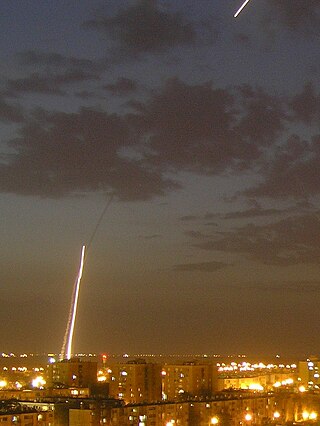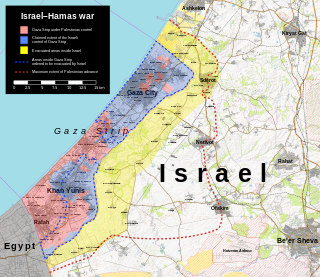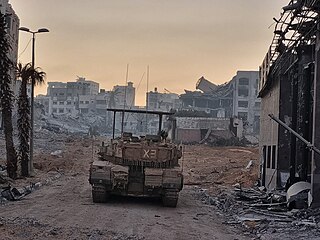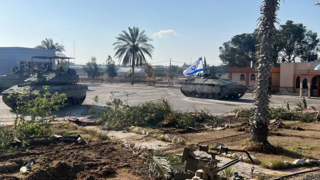
Shuja'iyya, also Shejaiya, Shijaiyeh, Shujayya, Shuja'ia, Shuja'iya, is the southern quarter of Old City of Gaza, and the only quarter of the Old City located outside the historical city walls. It is one of the largest neighborhoods in Gaza, once holding 92,000 to 100,000 residents. It is located east of Gaza's city center, and its nucleus is situated on a hill located across the main Salah al-Din Road that runs north–south throughout the Gaza Strip. Shuja'iyya contains several ancient structures, mosques and tombs. The Commonwealth War Cemetery is located 2 kilometres (1.2 mi) north of the commercial center of the neighborhood.

In November 2012, the Israel Defense Forces (IDF) launched Operation Pillar of Defense, which was an eight-day campaign in the Hamas-governed Gaza Strip, beginning on 14 November 2012 with the killing of Ahmed Jabari, chief of the Gaza military wing of Hamas, by an Israeli airstrike.

The 2014 Gaza War, also known as Operation Protective Edge, and Battle of the Withered Grain, was a military operation launched by Israel on 8 July 2014 in the Gaza Strip, a Palestinian territory that has been governed by Hamas since 2007. Following the kidnapping and murder of three Israeli teenagers in the West Bank by Hamas-affiliated Palestinian militants, the Israel Defense Forces (IDF) initiated Operation Brother's Keeper, in which it killed 10 Palestinians, injured 130 and imprisoned more than 600. Hamas reportedly did not retaliate but resumed rocket attacks on Israel more than two weeks later, following the killing of one of its militants by an Israeli airstrike on 29 June. This escalation triggered a seven-week-long conflict between the two sides, one of the deadliest outbreaks of open conflict between Israel and the Palestinians in decades. The war resulted in over two thousand deaths, the vast majority of which were Gazan Palestinians. This includes a total of six Israeli civilians who were killed as a result of the conflict.

The Battle of Shuja'iyya occurred between the Israel Defense Forces and the Izz ad-Din al-Qassam Brigades on 20 July 2014 during 2014 Israel–Gaza conflict in the Shuja'iyya neighborhood of Gaza City, in the Gaza Strip. Shuja'iyya, with 92,000 people in 6 sq-kilometres, is one of the most densely populated areas of the Gaza Strip. According to the IDF, it had become a "terrorist fortress", that between 8 and 20 July had fired over 140 rockets into Israel after the outbreak of hostilities. Casualty figures are not known with precision, partly because bodies were recovered long after the fighting, and people had also died of injuries afterwards. The UN Protection Cluster states that between the 19-20th, 55 civilians, including 19 children and 14 women, were killed as a result of the IDF's actions. At the time, estimates varied from 66 to about 120 Palestinians killed, with a third of them women and children, and at least 288 wounded. The UN figures of Palestinian casualties are preliminary and subject to revision. 16 Israeli soldiers were killed.
The following is a timeline of the 2014 Gaza War. Over 2014, Palestinians suffered the highest number of civilian casualties since the Six-Day War in 1967, according to a United Nations report, given the July–August conflict, and rising tolls in the West Bank and East Jerusalem. A spike in Israeli casualties also occurred. 2,256 Palestinians and 85 Israelis died, while 17,125 Palestinians, and 2,639 Israelis suffered injuries.

Gaza-Israel clashes began on 11 November 2018, when a botched Israeli covert operation carried out in the Khan Yunis area of the southern Gaza Strip killed seven Palestinian militants and one Israeli soldier. Exchanges of fire lasted for two more days, until a cease fire was achieved with Egyptian mediation. Some minor incidents and protests followed some two weeks after the cease fire, with decreasing intensity.
The year 2023 in Israel was defined first by wide-scale protests against a proposed judicial reform, and then by the Hamas-led attack on Israel on October 7, which led to a war and to Israel invading the Gaza Strip.

An armed conflict between Israel and Hamas-led Palestinian militant groups has been taking place in the Gaza Strip and Israel since 7 October 2023. It is the fifth war of the Gaza–Israel conflict since 2008, and the most significant military engagement in the region since the Yom Kippur War in 1973. It is the deadliest war for Palestinians in the history of the Israeli–Palestinian conflict, and has sparked an ongoing Middle Eastern crisis.

The Israeli invasion of the Gaza Strip is a major part of the Israel–Hamas war. Starting on 7 October 2023, immediately after the Hamas-led attacks on Israel, it began bombing the Gaza Strip; on 13 October, Israel began ground operations in Gaza, and on 27 October, a full-scale invasion was launched. Israel's campaign has four stated goals: to destroy Hamas, to free the hostages, to ensure Gaza no longer poses a threat to Israel, and to return displaced residents of Northern Israel. More than 35,000 Palestinians have been killed in Gaza since the Israeli operation began, including more than 7,800 children and 4,900 women, with another 10,000 people missing and presumed dead under the rubble of destroyed buildings.
The siege of Gaza City began on 2 November 2023, when the Israel Defense Forces (IDF) surrounded Gaza City, amid the Israeli invasion of the Gaza Strip, which was a counterattack to the 2023 Hamas-led attack on Israel. Gaza City is the most populated city in the Gaza Strip and the battle started on 30 October 2023, when Israel and Hamas clashed in Gaza City. According to Oxfam, there are about 500,000 Palestinians, along with 200 Israelis and other captives, were trapped in a "siege within a siege" in northern Gaza.

The battle of Khan Yunis, which evolved into the siege of Khan Yunis in late January 2024, began on 1 December 2023 in the midst of the Israeli invasion of the Gaza Strip.
Wissam Abu Hussein Farhat was a Head of Hamas's Shejaiya Battalion. He was the mastermind behind various attacks such as the Atzmona Massacre, the Nahal Oz attack and more.
Events in the year 2024 in Palestine.

On 6 May 2024, Israel began a military offensive in and around the city of Rafah as part of its invasion of the Gaza Strip during the Israel–Hamas war.

The insurgency in the North Gaza Strip is an armed conflict centered in the North Gaza Governorate, around the besieged Gaza City after Israel announced it had dismantled 12 Izz ad-Din al-Qassam Brigades battalions on 7 January.
The Battle of Shuja'iyya was a military engagement of the ongoing Israel-Hamas War between the Israeli Defense Forces of Israel and Hamas. The latter's allies, namely the Palestinian Islamic Jihad and the Popular Front for the Liberation of Palestine, also took part in the fighting. During the Israeli invasion of the Gaza Strip, Shuja'iyya was the last district in Gaza City that had not been subject to an Israeli ground invasion, and as a result many Palestinians who had not been able to evacuate south had sought refuge in the district. Despite this, the Israel Defense Forces had shelled and bombarded targets in Shuja'iyya for weeks before invading on December 4. On the 26th of December, Israel withdrew from Shuja'iyya, announcing that the local Hamas battalion had been defeated. Despite this, militants continued to attack Israeli forces within the town.

Mohammad Bhar was a 24-year-old Palestinian man with Down syndrome and autism who died after being mauled by an Israeli Oketz military dog in a Gaza Strip house during the Israel–Hamas war.









